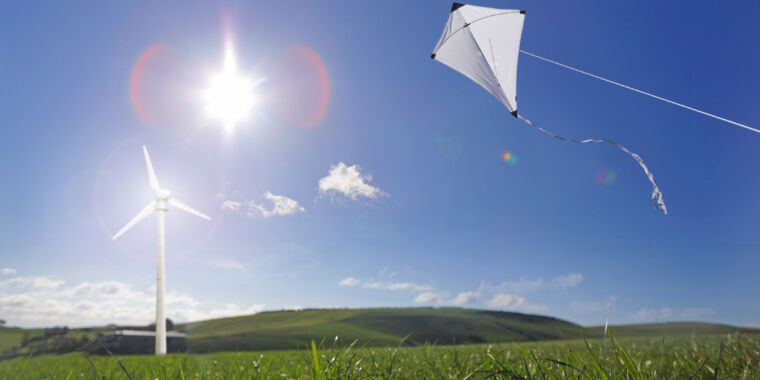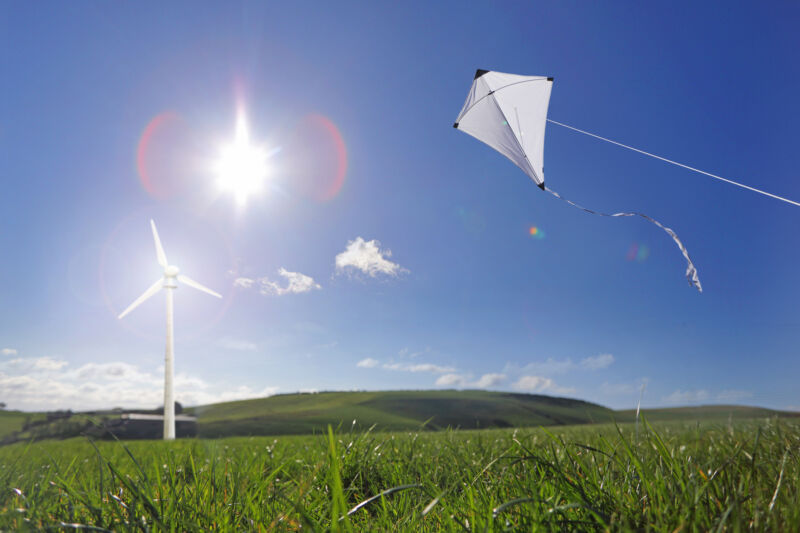

Peter Cade | Getty Images
Any kid who’s ever flown a kite has learned the lesson: Once you can get the kite off the ground and high into the air, you’re more likely to find a steady breeze to keep it aloft.
A fledgling wind power industry is taking that lesson to heart. Flying massive kites 200 meters or more above the ground, companies are using the wind they find there to generate electricity.
At least 10 firms in Europe and the United States are developing variations of this kind of kite power. If they succeed, kites could make it possible to build wind farms on land that isn’t windy enough for conventional wind turbine towers. Kites might also be a better choice for offshore wind power, and one day could even replace at least some anchored towers now in use.
“It’s cheaper to manufacture, cheaper to transport, and also has higher efficiency,” says Florian Bauer, co-CEO and chief technology officer of Kitekraft, a Munich-based company developing a kite power system. The carbon footprint is also much smaller, he says. “If you have all those advantages, why would anyone build a conventional wind turbine?”
But to become a widespread source of electricity, airborne wind energy, as it’s also called, needs to overcome a number of technological and commercial hurdles, as Bauer and colleagues describe in an upcoming paper in the 2022 Annual Review of Control, Robotics and Autonomous Systems. And it will need to demonstrate that it is safe, won’t harm wildlife, and won’t create intolerable noise and visual disturbances for neighbors.
At the moment, kite power is in its infancy. Most companies are working on relatively small pilot projects, and none have scaled up their technology to the megawatt range that would make them comparable to conventional wind turbines. But small versions are already on the market.
In 2021, Hamburg-based SkySails Power became the first company to offer a commercial product. Its production model consists of a soft, steerable kite up to 180 square meters in area. The kite is attached by an 800-meter tether to a ground station contained in a shipping container.
In operation, the kite makes large, graceful figure eights in the sky and powers a ground-based generator capable of an average output of 80 kilowatts — enough to supply electricity to about 60 average US households. That’s small compared with a typical 2.75-megawatt wind turbine but is similar in scale to many portable industrial diesel generators. The unit is designed for use in remote locations away from the power grid.
Eventually, companies want to build larger kites capable of generating megawatts of power. They envision hundreds of kites grouped together on wind farms, providing electricity to the grid.
| Source | Maximum power | No. of homes that can be powered |
|---|---|---|
| Existing SkySails PN-14 | 80 kW | 60 |
| Typical wind turbine | 2.75 MW | 2,160 |
| Proposed commercial kite | 3.5 MW | 2,800 |
| Small nuclear reactor | 582 MW | 465,600 |
Harnessing speedy winds
Wind close to the ground tends to be slowed down by friction with trees, buildings and hills, and the ground itself. So the higher you go, the faster the wind can travel—at 500 meters, the breeze moves between 3 to 7 kilometers per hour faster, on average, than it does at 100 meters. Over the last few decades, there have been a number of proposals for taking advantage of these speedier, elevated winds, including sending turbines up on lighter-than-air craft, or suspending them from stationary kites. But most companies, like SkySails, are pursuing an approach that makes use of steerable, computer-controlled kites that fly patterns in the air to harvest more energy.
Airborne wind energy systems use two basic ways to generate electricity. Ground-based approaches, like SkySails, use “pumping power” to run a generator on the ground. The ground-based end of the tether is wound around a winch, and as the kite flies across the wind it pulls against the tether and unwinds the winch, driving a generator that produces electricity. Then the kite is allowed to float while it is reeled back in, and the cycle starts again.
The other approach is to generate the electricity onboard the kite. Onboard generation uses a rigid kite, similar to an airplane wing, which supports small wind turbines. When the kite flies, the wind runs the turbines and electricity generated by the craft is sent down the tether to the ground station.
Kitekraft, Bauer’s company, uses the onboard method, which allows it to make dual use of the turbine blades. During launch and landing, the blades are powered by a motor and become propellers that allow the kite to fly and hover like an airborne drone. Once the kite is at the proper height, the turbines switch to generating energy from the wind.
Airborne wind energy kites generate electricity in two basic ways. “Pumping power” uses the kite’s pulling motion to spin a rotating drum on the ground, which powers a generator (producing electricity, yellow); when it reaches the end of the tether, the kite is retracted and starts again (using up a small amount of electricity, red). “Onboard power” is generated by turbines mounted on the kite itself. Onboard generation requires a rigid kite design.